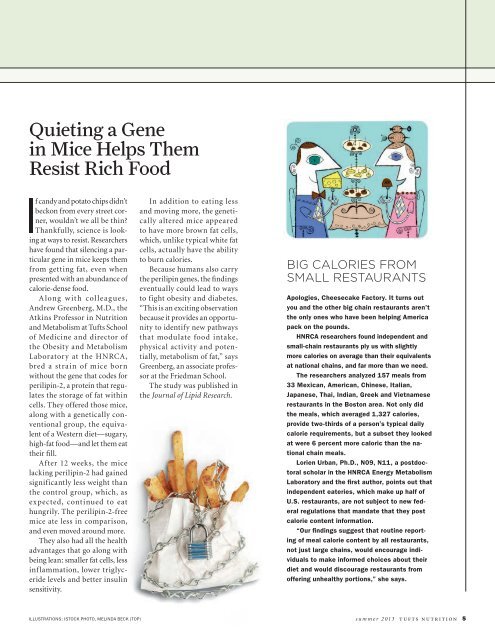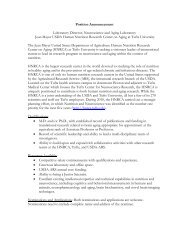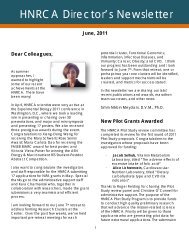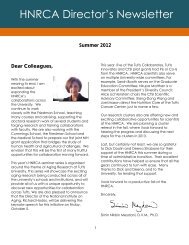Microbiome - Human Nutrition Research Center on Aging - Tufts ...
Microbiome - Human Nutrition Research Center on Aging - Tufts ...
Microbiome - Human Nutrition Research Center on Aging - Tufts ...
You also want an ePaper? Increase the reach of your titles
YUMPU automatically turns print PDFs into web optimized ePapers that Google loves.
Quieting a Gene<br />
in Mice Helps Them<br />
Resist Rich Food<br />
f candy and potato chips didn’t<br />
beck<strong>on</strong> from every street corner,<br />
wouldn’t we all be thin?<br />
Thankfully, science is looking<br />
at ways to resist. <str<strong>on</strong>g>Research</str<strong>on</strong>g>ers<br />
have found that silencing a particular<br />
gene in mice keeps them<br />
from getting fat, even when<br />
presented with an abundance of<br />
calorie-dense food.<br />
Al<strong>on</strong>g with colleagues,<br />
Andrew Greenberg, M.D., the<br />
Atkins Professor in <str<strong>on</strong>g>Nutriti<strong>on</strong></str<strong>on</strong>g><br />
and Metabolism at <strong>Tufts</strong> School<br />
of Medicine and director of<br />
the Obesity and Metabolism<br />
Laboratory at the HNRCA,<br />
bred a strain of mice born<br />
without the gene that codes for<br />
perilipin-2, a protein that regulates<br />
the storage of fat within<br />
cells. They offered those mice,<br />
al<strong>on</strong>g with a genetically c<strong>on</strong>venti<strong>on</strong>al<br />
group, the equivalent<br />
of a Western diet—sugary,<br />
high-fat food—and let them eat<br />
their fill.<br />
After 12 weeks, the mice<br />
lacking perilipin-2 had gained<br />
significantly less weight than<br />
the c<strong>on</strong>trol group, which, as<br />
expected, c<strong>on</strong>tinued to eat<br />
hungrily. The perilipin-2-free<br />
mice ate less in comparis<strong>on</strong>,<br />
and even moved around more.<br />
They also had all the health<br />
advantages that go al<strong>on</strong>g with<br />
being lean: smaller fat cells, less<br />
inflammati<strong>on</strong>, lower triglyceride<br />
levels and better insulin<br />
sensitivity.<br />
In additi<strong>on</strong> to eating less<br />
and moving more, the genetically<br />
altered mice appeared<br />
to have more brown fat cells,<br />
which, unlike typical white fat<br />
cells, actually have the ability<br />
to burn calories.<br />
Because humans also carry<br />
the perilipin genes, the findings<br />
eventually could lead to ways<br />
to fight obesity and diabetes.<br />
“This is an exciting observati<strong>on</strong><br />
because it provides an opportunity<br />
to identify new pathways<br />
that modulate food intake,<br />
physical activity and potentially,<br />
metabolism of fat,” says<br />
Greenberg, an associate professor<br />
at the Friedman School.<br />
The study was published in<br />
the Journal of Lipid <str<strong>on</strong>g>Research</str<strong>on</strong>g>.<br />
BIG CALORIES FROM<br />
SMALL RESTAURANTS<br />
Apologies, Cheesecake Factory. It turns out<br />
you and the other big chain restaurants aren’t<br />
the <strong>on</strong>ly <strong>on</strong>es who have been helping America<br />
pack <strong>on</strong> the pounds.<br />
HNRCA researchers found independent and<br />
small-chain restaurants ply us with slightly<br />
more calories <strong>on</strong> average than their equivalents<br />
at nati<strong>on</strong>al chains, and far more than we need.<br />
The researchers analyzed 157 meals from<br />
33 Mexican, American, Chinese, Italian,<br />
Japanese, Thai, Indian, Greek and Vietnamese<br />
restaurants in the Bost<strong>on</strong> area. Not <strong>on</strong>ly did<br />
the meals, which averaged 1,327 calories,<br />
provide two-thirds of a pers<strong>on</strong>’s typical daily<br />
calorie requirements, but a subset they looked<br />
at were 6 percent more caloric than the nati<strong>on</strong>al<br />
chain meals.<br />
Lorien Urban, Ph.D., N09, N11, a postdoctoral<br />
scholar in the HNRCA Energy Metabolism<br />
Laboratory and the first author, points out that<br />
independent eateries, which make up half of<br />
U.S. restaurants, are not subject to new federal<br />
regulati<strong>on</strong>s that mandate that they post<br />
calorie c<strong>on</strong>tent informati<strong>on</strong>.<br />
“Our findings suggest that routine reporting<br />
of meal calorie c<strong>on</strong>tent by all restaurants,<br />
not just large chains, would encourage individuals<br />
to make informed choices about their<br />
diet and would discourage restaurants from<br />
offering unhealthy porti<strong>on</strong>s,” she says.<br />
ILLUSTRATIONS: ISTOCK PHOTO, MELINDA BECK (TOP)<br />
summer 2013 tufts nutriti<strong>on</strong> 5







